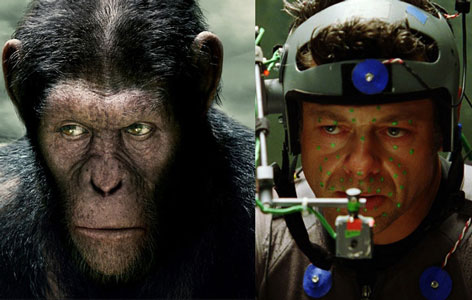Andy Serkis is the undisputed go-to actor for motion capture after nearly snagging an Oscar nomination for his star-making role as Gollum in The Lord of the Rings Trilogy and first entering the monkey business as King Kong in Peter Jackson’s epic 2005 remake.
While Serkis will also appear in the motion-captured Adventures of Tintin and reprise his Gollum role in the two-part Hobbit movies, Serkis will next be seen in a motion capture role in next month’s Rise of the Planet of the Apes as the chimpanzee Caesar. At this past weekend’s Comic-Con, Serkis went into detail about how he became a chimp with the Wall Street Journal.
While to most it would seem obvious that watching chimp behavior would be the first start, Serkis actually explains that it’s actually a very limited resource. “There’s only so far you can get watching generic chimp movies. That was only the first rung on the ladder for me. And I needed something more solid, so I watched a lot of footage of this particular chimp named Oliver but known as humanzee. In the 1970s, there was a lot of experimentation done on this guy because he was brought up with human beings and displayed this phenomenal human like qualities in the way he sat, the way he stood. He was bipedal and whenever he walked into a room, everybody was breathless.” Since Serkis is playing a very intelligent, very domesticated chimp as Caesar, it seems like he tried to find the most “real life” model.
Additionally, since Caesar is a “gifted” chimp with mental abilities far beyond those of the average chimp, he also studied gifted children. “When I played Caesar as a young chimp, I was looking a lot of footage of gifted children. Children that can play concertos when they’re four-years-old or are brilliant at mathematics. Then I worked with Rupert [Wyatt, director] to chart out the changes.”
Serkis even elaborates that much of the performance actually comes from small gestures, explaining that he was sure to use subtle hand movements like “The dexterity of the fingers of the chimpanzee. The way that he holds things or the way he twiddling a straw in his fingers” to indicate the difference between human and chimp body language. In fact, one major difference between the original Apes films and this upcoming film is that Serkis believes that while the make-up of the original series is “iconic and amazing,” its rigid nature prevented the subtle facial expressions that motion capture allows. Serkis credits much of this ability to convey subtle movements as an ultimate tool for his performance.
Rise of the Planet of the Apes opens in theaters on August 5.



